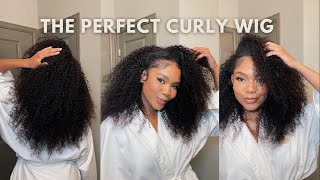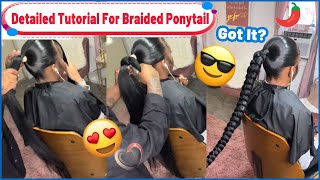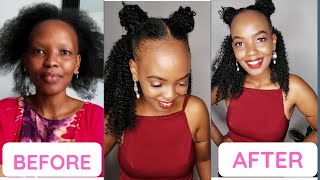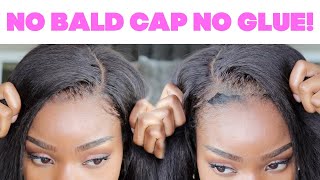Response To “5 Hair Blogger Falsehoods Debunked by a Professional Cosmetologist"
 You know what makes twitter amazing? The fact that you can listen to a conversation and not ever be called nosy or inquisitive. Twitter has given us a platform as consumers, bloggers, vloggers and business people to share our ideas, experiences and colorful opinions sometimes despite there validity.
You know what makes twitter amazing? The fact that you can listen to a conversation and not ever be called nosy or inquisitive. Twitter has given us a platform as consumers, bloggers, vloggers and business people to share our ideas, experiences and colorful opinions sometimes despite there validity.
I am not a consistent ‘tweeter’ myself but I do read twitter posts and blog posts quite often. Last week the beautiful Bella of Afrobella wrote a blog post that was titled ‘The 5 Hair Blogger Falsehoods Debunked‘ and of course it caught my attention especially since I am a blogger and in her introduction I thought she posed an interesting question.
Bella asked
How do you really know you are following a sensible regimen if it is not routed in hair science and acquired education?
The premise of the question was based on her interview with Camille E Reed details of which are on her blog. Camille Reed is the creator of Noire Design Concepts salon in Silver Spring MD and apparently on Twitter she has had alot to say about bloggers providing misinformation to women who seek knowledge about natural hair care.
I read through the post and honestly I felt that some of the comments were not quite sound in some cases and in others downright unfair. What Ms Reed has termed as falsehoods are actually things that in my own personal experience has lead to my own hair success. With that in mind I felt obliged to debunk the debunker, so here goes . . .
Bella wrote
Meet Camille E. Reed, the creator of Noire Design Concepts salon in Silver Spring, MD. She’s a genius with natural hair and an expert in hair color. She is licensed, she is professional, and she is frustrated with some of the misinformation that’s proliferating on the internet.
Camille sees it on an ongoing basis – the women who come into her salon with hair damage resulting from following bad advice they found from an unprofessional source. She’s here to debunk what she sees as the top 5 hair blogger falsehoods. Take it away, Camille!
Camille said:
Hi everyone, my name is Camille E. Reed. I am an educator, licensed cosmetologist and natural hair stylist of 14 years and also the owner of Noire Salon in Silver Spring, MD. During the course of my career, I have estimated that around 17,000-26,000 heads of hair have sat underneath my hands and have been scrupulously tended by them. So it’s a bit startling to hear some of the natural hair bloggers spreading misinformation about hair care. I am sure they meant no harm. However, what most stylist and pros know cannot be Googled or passed down as second-hand information, without a great deal of both practical wisdom and a keen understanding of cosmetic chemistry. Here I am going to assist many of you back on to the right path. My concern is that some of this misinformation will cause your strands to behave in a way that causes your home hair care to become troublesome, over time. There have been terms that the hair bloggers are using or have created, that are neither scientifically sound or are what professionals use (and have been using) since the onset of Modern Cosmetology in the 19th and early 20th century.’
Ouch!
Before I get into what the terms are that bloggers have created, let me address the ‘spreading misinformation’ part. The coolest thing about the natural hair movement is the comraderie among women who come together to share experiences centered around a new found love for natural hair. A great blogger will share her experience, her successes, her failures and more often than not we are all given the opportunity to see the blogger’s progress for our selves through pictures,video or meetups through the years.
With that said, when a person shares an ‘experience’ especially a positive one, it attracts like minded individuals who want to hear or read about it. Granted it might not be rooted in formal education or science but does that mean it should be discounted and considered misinformation, or second hand? I am sorry but there is nothing second hand about my own hair successes based on my own regimen that I have shared on my own blog!
Which brings us to the one thing that Camille thinks will lead to sudden death of our strands.
What Camille Reed says about Cowashing
This is where bloggers and vloggers are instructing readers and subscribers to forgo using shampoo and “wash” their hair with conditioner.
The problem with this method is that it promotes the misuse of product. Within Cosmetic chemistry, certain products have certain roles. The shampoo, with either its surfactants or saponins, opens up the hair cuticle in an alkaline state to release dust, dirt, lipids (fats) and other products from the strand. The cleaners are molecularly attracted to these items and adhere. Water comes in as a solvent and removes both the shampoo and residue. Conditioners come in at an acidic state to relax the cuticle and bring pH balance back to the skin. Commercial conditioners (the ones people are using for these co-washes) contain an additional number of mild chemical sealants to add a bit more protection to the hair strand. It is designed to mimic the natural fat that comes from our scalp, called Sebum (also slightly acidic).
Misuse of conditioner leaves several layers of film on the strands that, after a few months, will start to retard the cuticle from opening properly to allow the strand to swell with water. The result is a low-porosity strand that becomes increasingly fragile and starts to break.
The good thing for ladies in this current hair care market is that companies are making sulfate free shampoos and organic shampoos that contain saponins (natural, non chemical cleansers) that will get your hair clean WITHOUT over-stripping. Understand that all of these other methodologies need to be carefully scrutinized and compared to actual cosmetic science before they are co-opted.
I agree co-washing is not a scientific term, however I disagree with the term ‘misuse’ within the context of what she is trying to explain. I think the natural hair community knows exactly what the roles of shampoos and conditioners are, after all we have been using them for years, relaxed or not.
As a matter of fact the very reason she has stated that the fats used in conditioners are designed to mimic the natural fat that comes from our scalps is why we have chosen to use conditioners more often than we would shampoo! Black people produce a lots less sebum than other races so using more conditioner than shampoo makes sense.
Additionally if she listened carefully enough she would also hear terms like clarify, cleanse or ACV rinses which indicate that women are aware of any film or any layers that will need to be removed after using conditioner on a consistent basis.
Oh and don’t be fooled, we know about the use of protein as well to fix any porosity issues we may develop and we even read and research the ingredients on the back of our products to ensure that we keep up to date with ‘cosmetic science’.
To add to this manufactures are making new hybrid products to help women who choose to forgo shampoos. They have now started to create cleansing conditioners for the co-wash that way we can condition and cleanse all at the same time, go figure! But maybe its just the term ‘cowashing’ that is the problem. If that’s the case the easy fix is just find another name, I will leave that to the professionals!
What Camille Reed says about Dusting aka trims
I see more bloggers and vloggers instructing young ladies not to cut or trim their hair, showing off what they deem to be fabulously long hair without having been cut in multiple months or years.
The ends of your hair are the oldest and weakest part of your hair fiber. Yes, hair is a fiber and like most fibers, it has a shelf life. The ends are nearing the end of their shelf life and no amount of product will revive or repair fiber that is old and weather or style beaten. It just simply needs to be removed in small, but regular increments throughout the year.
I stick to the rule that 6 micro trims (read ¼” to ½”) every two months, will leave you with more than enough healthy hair to work with, especially since most healthy women average about an inch of growth in an 8 week time period.
A trim is not something easily done at home. Take the leap, do the research, find a pro. If you can’t find one in your area, contact me @Noireboss1 on Twitter and I will help you! I have pro friends all over the country that are ready and willing to help.
Without sounding too argumentative the first sentence is simply not true of all bloggers or vloggers, trimming is always encouraged and is considered a very healthy part of a great regimen.
The debate might be, how often and what method, for example some women choose to use the ‘search and destroy’ method which involves just trimming strands with knots, splits and other miscellaneous damage. That way you get to keep majority of the length. Others choose to do a blunt trim every few months to maintain their style.
I would also like to point out that hair growth rate is one of the few things in hair care that is genuinely genetic and while some of you have relatively faster hair growth*, no doubt many others are growing very slowly so generalizing trimming schedules is a big mistake. Alma (of BHI) has only trimmed her hair in the traditional sense two times in her journey to waist length. This is because she knows that she has very slow growing hair (4 inches a year). If she was to mindlessly trim 1/2 inch off every two months just because a cosmetologist said so, that would be 3 of her 4 inches gone every year!
Not convinced yet? Cathy Howse the woman most people in the hair community would recognize as one of the first to write about the subject of black hair after she grew her relaxed hair down to mid back length, says quite clearly in her classic book Ultra Black Hair Growth that you should not trim your ends often.
Might I also add that nature already has it’s own in-built ‘shelf life’. It’s called the hair’s life cycle which spans 3-7 years. Now if you are going to use chemicals and heat & style too often then of course you can expect that your ends will have all manner of damage which needs to be trimmed but if you are following a good regimen with protective styling and keep manipulation down to a minimum then naturally your ends will be healthy and strong.
Bottom line is hair growth rate, which is very individual, should dictate trimming schedule. I would go as far as to say that there is nothing scientific or deeply educational about cutting 1/2 an inch off every two months just because. You must do what is right for you when it comes to trimming. We call our ‘regular trims’ advice a rule of thumb in these parts, it is not set in stone.
Stay tuned for more debunking in part two. By the way, if you haven’t read the post on Afrobella yet, it can be found in it’s entirety here.




